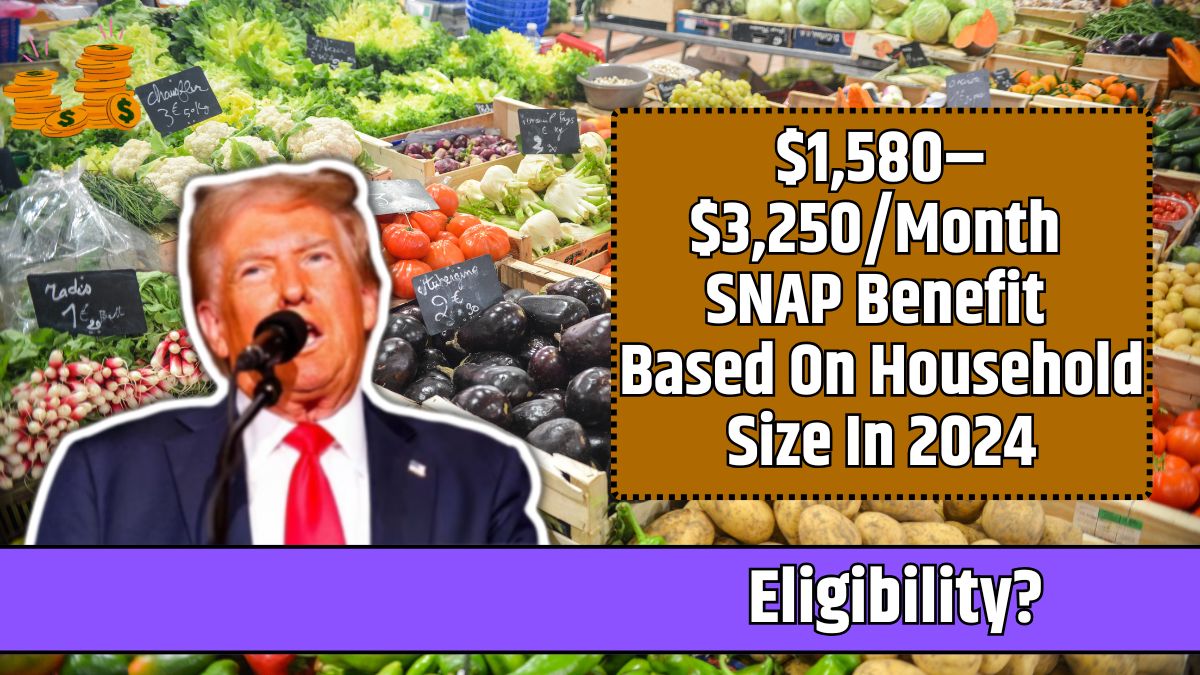The Supplemental Nutrition Assistance Program (SNAP), also known as food stamps or EBT (Electronic Benefits Transfer), continues to provide essential support to millions of low-income individuals and families.
In 2024, this vital program helps households afford nutritious food, with monthly benefits ranging from $1,580 to $3,250 depending on household size, income, and expenses.
Here’s everything you need to know about SNAP benefits in 2024, including eligibility criteria, application steps, and strategies to maximize your benefits.
What Are SNAP Benefits?
SNAP benefits are issued via an EBT card, which functions like a debit card, and can be used at approved retailers to purchase eligible food items.
The program ensures that low-income households can access healthy food without sacrificing other necessities like housing or medical care.
Key Features
- Coverage: Provides funds for nutritious food.
- Payment Method: Benefits are loaded monthly onto an EBT card.
- Usage: Accepted at most grocery stores, supermarkets, and some farmers’ markets.
SNAP benefits cannot be used for non-food items, alcohol, tobacco, or hot prepared foods.
2024 SNAP Eligibility
Eligibility for SNAP benefits depends on various factors, including household size, income, and allowable expenses.
1. Household Size and Composition
A household includes individuals who live together and prepare food together. This can include families, single individuals, or households with elderly or disabled members.
2. Income Limits
To qualify, a household’s gross monthly income must be at or below 130% of the Federal Poverty Level (FPL).
| Household Size | Gross Income Limit |
|---|---|
| 1 Person | $1,580/month |
| 2 People | $2,136/month |
| 3 People | $2,691/month |
| 4 People | $3,246/month |
| 5 People | $3,801/month |
Net income (after deductions for housing, child care, medical expenses, etc.) is also considered for eligibility.
3. Asset Limits
Some states impose asset limits, such as savings or vehicle ownership, but certain assets (e.g., homes or retirement accounts) are excluded.
4. Special Circumstances
Elderly, disabled individuals, or households with young children may qualify for higher benefits or lenient requirements.
How Much Can You Receive?
The amount of SNAP benefits depends on your household size, income, and expenses. Below are the maximum monthly benefits for 2024:
| Household Size | Maximum Benefit |
|---|---|
| 1 Person | $281/month |
| 2 People | $518/month |
| 3 People | $740/month |
| 4 People | $939/month |
A family of four, with income and housing expenses considered, might qualify for $700–$900/month in benefits.
How to Apply for SNAP
Step-by-Step Process
- Check Eligibility
- Use the USDA’s SNAP Pre-Screening Tool to determine if you qualify.
- Complete the Application
- Each state manages SNAP applications. Apply online, in person at a local office, or by mail.
- Provide required details, including:
- Household composition.
- Income and expense documentation.
- Proof of identity and residency.
- Attend an Interview
- Participate in a phone or in-person interview where a caseworker reviews your application.
- Receive a Decision
- Once approved, you’ll receive an EBT card loaded with your benefits.
What Can You Buy with SNAP?
SNAP benefits can be used for:
- Fruits and vegetables.
- Meat, poultry, and fish.
- Dairy products.
- Bread and cereals.
- Non-alcoholic beverages.
Prohibited Items: Alcohol, tobacco, hot prepared meals, vitamins, supplements, and non-food items like cleaning supplies.
Maximizing Your SNAP Benefits
Tips to Stretch Your Benefits
- Plan Meals:
- Create a weekly meal plan to avoid overspending.
- Buy in bulk and cook larger portions to save costs.
- Shop Smart:
- Use coupons and focus on in-season produce.
- Choose whole foods over processed items for better value.
- Double Your Benefits:
- Programs like Double Up Food Bucks match your SNAP dollars at participating farmers’ markets.
- Try Online Grocery Shopping:
- Many states allow SNAP benefits for online shopping at retailers like Walmart and Amazon.
Additional Resources
SNAP is part of a broader network of programs designed to support low-income families:
| Program | Purpose |
|---|---|
| WIC | Assists women, infants, and young children. |
| TANF | Provides financial assistance for families. |
| Free School Meals | Ensures children receive nutritious meals at school. |
| Local Food Banks | Offers free food to those in need. |
These complementary programs can provide additional support beyond SNAP.
The $1,580–$3,250/month SNAP benefits remain a cornerstone of support for millions of Americans in 2024.
By understanding eligibility, applying correctly, and maximizing your benefits, you can access vital resources to ensure food security and a healthier lifestyle for your family.
















